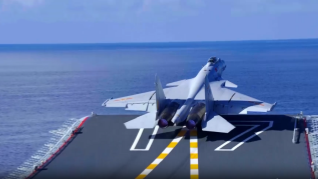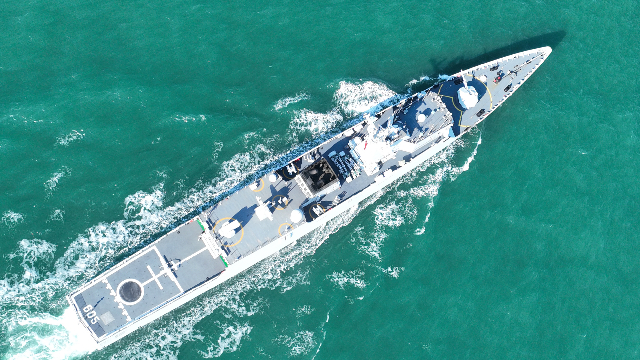BEIJING, Aug. 1 (Xinhua) -- The Military Museum of the Chinese People's Revolution in Beijing has received countless visitors this summer. In the exhibition hall, young children could be seen gathering around a display case containing a rusty bolt-action rifle.
Known as Hanyang Zao, meaning Made-in-Hanyang, this rifle was used in the Nanchang Uprising led by the Communist Party of China (CPC) on Aug. 1, 1927, a day now remembered as the founding day of the Chinese People's Liberation Army (PLA).
Over 8,000 km away, meanwhile, China's J-35A stealth fighter was a superstar at the 2025 Paris Air Show. This home-developed Chinese fighter jet manifests the growing combat capabilities and technological prowess of the PLA.
The year 2025 marks the 98th anniversary of the PLA's founding. Just as China's weaponry has seen remarkable evolution over the years, the Chinese military has also continuously strengthened itself by reinforcing the primacy of political guidance and advancing comprehensive reforms. Notably, significant progress has been made in this regard over the past decade.
ENHANCING POLITICAL LOYALTY
"Without the unprecedented reinforcement of political work, the great changes that took place in the people's military in the new era wouldn't have been possible," Chinese President Xi Jinping said at a high-level military conference in June 2024.
This meeting took place in Yan'an, northwest China's Shaanxi Province, a city of utmost significance in the history of China's revolution. Before the meeting, Xi, also general secretary of the Communist Party of China Central Committee and chairman of the Central Military Commission (CMC), led senior military officers to visit the revolutionary relics at Wangjiaping, where the Party's military headquarters were stationed from August 1937 to March 1947.
At the conference, Xi stressed that political work is always the lifeline of the country's military, the armed forces must always be led by those who are reliable and loyal to the Party, and there must be no place for corruption within the military.
These remarks echoed a similar 2014 meeting in Gutian, Fujian Province, where Xi convened a military political work conference amid efforts to sharpen fighting capacity and curb corruption.
Gutian was a historically significant township, where the landmark 1929 meeting was held to establish the Party's absolute leadership over the armed forces, or "the Party commands the gun" in short.
At the conference in 2014, Xi reiterated that this principle shall always be firmly upheld.
In the following decade, Xi's thoughts on strengthening the military have been widely carried out, bringing greater unity in thought and firmness in action.
At the same time, corruption is being rooted out, loyalty is being strengthened, and unhealthy practices are being corrected to solidify the foundation for future victories.
Recently, the CMC issued new regulations on strengthening political work, aiming to uphold the military's fine traditions, eliminate the lingering impact of corrupt officers, and restore image.
As observers noted, without strong military capabilities, an army may fall before its enemies; and without firm political commitment, it may collapse from within.
MILITARY REFORM CONTINUES
It has been 10 years since China deepened its reforms of national defense and the armed forces. A decade ago, Xi ordered the reorganization of the military administration structure and military command system, and the building of an efficient, modern military capable of succeeding in information-age warfare.
Thanks to this reform initiative, troop numbers were reduced by 300,000. This cut marked a historic shift, as Army personnel dropped below 50 percent of the total for the first time, non-combat unit staffing was almost halved, and officer numbers fell by 30 percent.
This reform effort also created new front-line combat units -- such as combined arms brigades, air assault brigades and aircraft carrier battle groups.
Military reform has significantly enhanced operational capabilities. The Army has become faster and more effective at fighting in various environments, while the Navy has expanded its defensive reach from near-seas to open oceans. The Air Force has integrated air and space domains, and the Rocket Force has strengthened both its nuclear and conventional deterrents.
Observers said the PLA is now leaner, better organized and structurally optimized -- fundamentally changing its long-standing land-based warfare force structure. The command chain of the Chinese military has also become increasingly streamlined, while force projection has grown ever more efficient.
Reform efforts remain ongoing. In April 2024, the Information Support Force was established, replacing a previous structure -- a move that underscores the PLA's intensified focus on achieving data dominance.
These efforts will be on full display on Sept. 3, when China holds a military parade to mark the 80th anniversary of the victory in the Chinese People's War of Resistance against Japanese Aggression and the World Anti-Fascist War.
Alongside the latest generation of conventional weapons, the parade will feature unmanned intelligent systems, underwater combat units, cyber and electronic forces, and hypersonic weapons -- highlighting the PLA's growing capacity to harness emerging technologies, adapt to the evolving character of warfare, and prepare to prevail in future conflicts.
The Chinese military has always been a staunch force for upholding world peace, and Chinese troops with UN peacekeeping experience will participate in the parade, Wu Zeke, a senior officer of the CMC Joint Staff Department, told a press conference in June.
"This arrangement not only highlights China's solemn commemoration of the victory in the war, but also demonstrates the country's commitment to fulfilling international obligations and safeguarding world peace," Wu noted.













